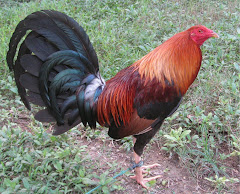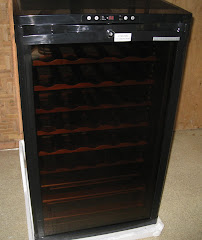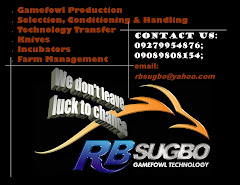Sunday, November 1, 2009
Probiotics for chickens
by K.J. Theodore of www.shagbarkbantams.com
What the heck are probiotics??
PROBIOTICS are a dietary supplement that increase the population of the 'good' bacteria (micro flora), which are needed in the intestinal tract in order to process food properly. The use of probiotics as a daily supplement has become a popular routine in the commercial poultry industry, particularly following antibiotic treatment.
Good bacteria also help fight off the bad bacteria that passes through the system, before it has a chance to take hold. Introducing probiotics into the digestive system everyday to ward off bacterial infection is known as 'selective exclusion'.
Selective exclusion is a very good way to keep your birds healthy and disease resistant throughout their life. It’s good to use probiotics in my own flock, along with a vitamin and mineral supplement on a daily basis. I also use probiotics before, during, and after both showing and breeding. For showing, the probiotics help the birds ward off most illnesses they could become exposed to different environment. For breeding, one benefit is the tendency of the laying hens to drink more water, when the water is treated with flavored probiotics. Both breeding and showing are very stressful times in your birds' lives, and the vulnerability to disease increases during those times. The use of probiotics helps to reduce that vulnerability.
During times of stress or the use of antibacterials (antibiotics), hormonal changes can occur, causing the pH of the small intestine to rise. This allows existing bad bacteria to take a foothold in the lining of the intestine because of the deterioration of the protective mucus lining. Because of this, the 'villi' (little fingers), which normally exist in the small intestine, can be lost. Villi slow the movement of food as it passes through so that nutrients can be absorbed through the intestinal wall. The term 'going light' can occur when villi are lost. Increasing good gut bacteria through the use of probiotics will compete against the bad bacteria, change the pH environment, allow nutrient absorption, and prevent infection. Probiotic treatment has also shown an ability to stimulate appetite - a valuable thing when trying to maintain the weight of an ailing bird.
If you're not inclined to use probiotics on a daily basis, then at least consider their use immediately following antibiotic treatment. When your bird is treated with antibiotics, all bacteria are killed off - good and bad. Treating with probiotics immediately after the use of antibiotics, help to repopulate the gut with the good bacteria. In many cases, this can ward off a secondary infection, such as E Coli. E. Coli has been shown to exist in virtually all manure samples, but only becomes a problem when the digestive environment is friendly to its reproduction.
Probiotics help prevent coccidiosis
Avian coccidiosis plagues poultry producers large and small costing an estimated $1.2 billion in losses every year. The pesky disease is caused by infection with the avian parasite Eimeria maxima. And since this parasite rapidly evolves to stay at least a half a step ahead of vaccines, scientists at the Agricultural Research Service (ARS) have embarked on a quest to fight the disease through boosting chicken immune systems. This is a refreshing development in our “throw the next drug at it” culture where we expect to substitute chemistry for the much harder work of promoting animal health more holistically.
According to a recent ARS report, scientists discovered that chickens reared in confinement shed many fewer oocytes (eggs) of Eimeria maxima when they were fed ground green tea for two weeks before they were challenged with the parasite in question. Similar results were discovered when Pediococcus-based probiotics and yeast-based probiotics were in the feed. What’s significant about these findings is that they suggest that probiotics can significantly reduce the spread of coccidiosis through the flock. Incidentally, these tea and other probiotic eating chickens gained more weight and had increased levels of immune-boosting cytokines in their systems than the control group too.
Hops, plum powder, safflower and a few other phytonutrients have also been shown to boost chicken immune systems and are linked to reduced levels of Salmonella infection and even reduced incidence of some kinds of chicken tumor growth. It feels like we’re reinventing the wheel by looking beyond the “magic bullet” approach to animal health and now admitting that dietary diversity is important after all. Who would have thought that trying to create an artificial chicken ration to feed chickens in crowded conditions might not be the best way to prevent disease?
Perhaps all those free-range chicken folks are on to something, but even if you can’t raise your birds on grass, you can at the very least bring a variety of plant material to them … and you can add a little green tea or plum powder to their ration to boot.
Food Supplements that Fortify Fowl
Poultry infected with the parasite Eimeria maxima usually develop avian coccidiosis, a disease estimated to cost producers globally more than $1.2 billion every year. So Agricultural Research Service (ARS) immunologist Hyun Lillehoj has been working with colleagues in ARS and around the world to find dietary supplements that strengthen the poultry immune system.
Lillehoj, at the ARS Animal Parasitic Diseases Laboratory in Beltsville, Md., cooperated on the research with scientists at South Korea's Gyeongsang National University College of Veterinary Medicine.
The researchers found that chickens that consumed ground green tea for two weeks prior to parasitic infection produced significantly fewer fecal E. maxima oocysts than the control group. This finding could help reduce the spread of infection in poultry houses.
Working with ARS visiting molecular biologist Sung-Hyen Lee and Imagilin Technology LLC, in Frederick, Md., Lillehoj evaluated the effects of adding commercial probiotics to poultry diets. Probiotics are health-promoting dietary supplements derived from live bacteria or yeasts.
Chickens eating diets supplemented with Pediococcus-based probiotics reduced their oocyte production, increased the production of cytokines essential for a strong immune response, and experienced improved weight gain.
Poultry immunities got a similar boost from a combination of Pediococcus and a yeast-based commercial probiotic product. Chickens that consumed a probiotic combination of lactic acid bacterium and yeasts also showed a significant antibody response to parasites.
Lillehoj, Lee, and other colleagues from South Korea collaborated with scientists at the Rural Development Administration—South Korea's national agricultural research organization—to see if other phytonutrients might also be beneficial. They found that plum powder supplements stimulated spleen immune cell production and killed tumor cells. Infected poultry fed with the supplement also gained weight and reduced parasite shedding. Supplements of safflower, which have been used by traditional Chinese practitioners for thousands of years, were found to be similarly beneficial.
Read more about this research in the May/June 2009 issue of Agricultural Research magazine.
ARS is the principal intramural scientific research agency of the U.S. Department of Agriculture.
[Top]
Probiotics Help Produce Safer, Healthier Chickens, Researchers Discover
December 12, 2006 - News Release
Giving chickens probiotics – dietary supplements that contain live beneficial bacteria – stimulates their immune system and reduces the Salmonella bacteria in their gut by more than 99 per cent, a University of Guelph professor and an Agriculture and Agri-Food Canada food researcher have found.
“We looked at the immune-enhancing ability of the probiotic and, lo and behold, the probiotic actually seems to be quite an immune stimulator,” said Shayan Sharif, a pathobiology professor in the Ontario Veterinary College, who worked in collaboration with James Chambers of Agriculture and Agri-Food Canada. Their research was recently published in Clinical and Vaccine Immunology.
This means chickens treated with probiotics early in life are able to mount higher immune responses and, as a result, may be better protected against disease-causing microbes, said Sharif. “After looking at the antibodies in the intestine and blood of the chickens, we found that the antibodies were more than twice as high in chickens treated with probiotics.
The researchers also looked at two kinds of Salmonella that are most prevalent in Canada and found that some probiotics reduce, to less than one per cent, the level of colonization of Salmonella in the chicken gut. The gut contents sometimes contaminate carcasses, depending on how the meat is processed, which puts consumers at risk of getting sick, said Sharif. “Reducing Salmonella in the chickens’ digestive tract could lead to more Salmonella-free chicken products on store shelves.”
In the studies, one-day-old chicks were treated with probiotics and one day later were given Salmonella bacteria. The immune status and Salmonella bacterial load in the chicks was examined at various intervals and the positive results surfaced quickly, said Sharif.
Sharif and Chambers’ study looked at a repertoire of probiotics alone and in combination with prebiotics (food substances that promote the growth of beneficial bacteria in the intestines). “We also found that the combination of prebiotics and probiotics could reduce the existence of bad bacteria − those that are harmful for humans − in the chicken gut substantially,” said Sharif.
“There’s a hope that probiotics could actually work as a replacement for antibiotics, or at least be used to work in a complementary fashion with antibiotics,” he said. Probiotics are available from veterinary pharmaceutical suppliers and are fairly inexpensive. The overuse of antibiotics in chickens is a concern that has already caused European countries to place restrictions on prophylactic antibiotic use within their poultry industry.
“If the same restrictions were enforced here, it would cause problems in the poultry industry, so it would be great if we could come up with a better system using probiotics to work hand-in-hand with antibiotics,” said Sharif.
Welcome. To read the articles, please click post link or month, then subsequent post link.
-
▼
2009
(71)
-
▼
November
(9)
- MANALU sets feeding of street children
- Gamefowl's natural biorhythm: A study by RB Sugbo ...
- Probiotics for chickens
- Llamado Tayo: Sugbo Agro
- Llamado Tayo: Malungkot na pangyayari
- Llamado Tayo: Ang Lemon
- Llamado Tayo: Iba ang Pinoy
- Llamado Tayo: Sa sabong hindi sugal ang mahalaga
- Llamado Tayo: 3 cocks sa Baras, Rizal
-
▼
November
(9)
Ponkan broodcock

One of the ponkan broodcocks being readied by RB Sugbo for the incoming breeding season. RB Sugbo is among the gamefowl farms very much involved in the Masang Nagmamanok (MANA) Inc. nationwide gamefowl dispersal program.
Another ponkan

Another ponkan broodcock in the trio pen.
Mana: Dami at Pagkakaisa
Walang duda napakalaki na ng pinagunlad ng sabong mula sa paging libangan tuwing araw ng Linggo, ito ngayon ay isa nang napakatanyag na isport, malaking industriya at kaakitakit na mapagkakitaan.
Napakarami nang nagpapalahi ng manok panabong. Nagsilabasan ang mga babasahin at programa sa telebisyon ukol sa sabong.
Sa bawat nagpapalahi, ilan ang tagapagalaga ng kanyang manok? Sa bawat may-ari ng sabungan, ilan ang naghahanapbuhay sa sabungan niya? Sa bawat kasali sa derby, ilan ang nagbabayad sa pinto upang manood? Sa bawat malaking sabungero, ilan ang mayroon lang iilang pirasong tinale sa kanilang bakuran? Dapat lang, at napapanahon na siguro, na ang masang sabungero ay mapagtuonan ng pansin, mabigyan ng kinatawan, at, marinig ang boses sa isport at industriya ng sabong.
Ito ang nais abutin ng MANA (Masang Nagmamanok), isang pambansang kilusan at samahan ng mga masang sabungero. Ang mga layunin ng MANA ay ang sumusunod:
1. Ang pangalagaan ang kapakanan ng mga maliit na sabungero, partikular na, ang mga naghahanapbuhay sa sabungan. Inaasam na sa darating na panahon, ang mga handlers, mananari, casador, kristos, sentensiyador, farm hands ay magkakaroon ng mga benepisyo tulad ng insurance, pension at iba pa.
2. Ang mapatingkad ang kaalaman ng ordinaryong sabungero sa pagmamanok. At, sila’y mabigyan ng pagkakataon na magkaroon ng angkop na materyales sa pagpapalahi at paglalaban.
3. Ang ipaglaban ang sabong sa gitna ng banta na itoy gawing labag sa batas tulad ng nangyari kamakailan lang sa Estados Unidos, at ipreserba ito bilang isport, hanapbuhay, industriya at bahagi ng ating kultura at tunay na mana.
4. Ang magtulungan at makipagtulungan sa iba pang haligi ng industriya sa ikabubuti ng sabong at ikauunlad ng lahat na mga sabungero.
Inaasahan na matupad ng MANA ang nasabing mga layunin pamamagitan ng pagpakita ng dami at pagkakaisa.
Ang pagkatatag ng MANA ay bunsod ng mungkahi ni kamanang Boying
Ang Llamado Tayo ay tumatalakay sa ibatibang aspeto sa pagmamanok at binabasa ng napakarami arawaraw, kaya di nagtagal marami ang sumapi sa MANA.
Kasunod nito, ang MANA ay nakapagpaseminar sa ibatibang lugar at rehiyon ng Pilipinas, sa tulong ng mga kumpaniya tulad ng Excellence Poultry & Livestock Specialist, Bmeg-Derby Ace, Sagupaan, Secret Weapon, at Thunderbird.






